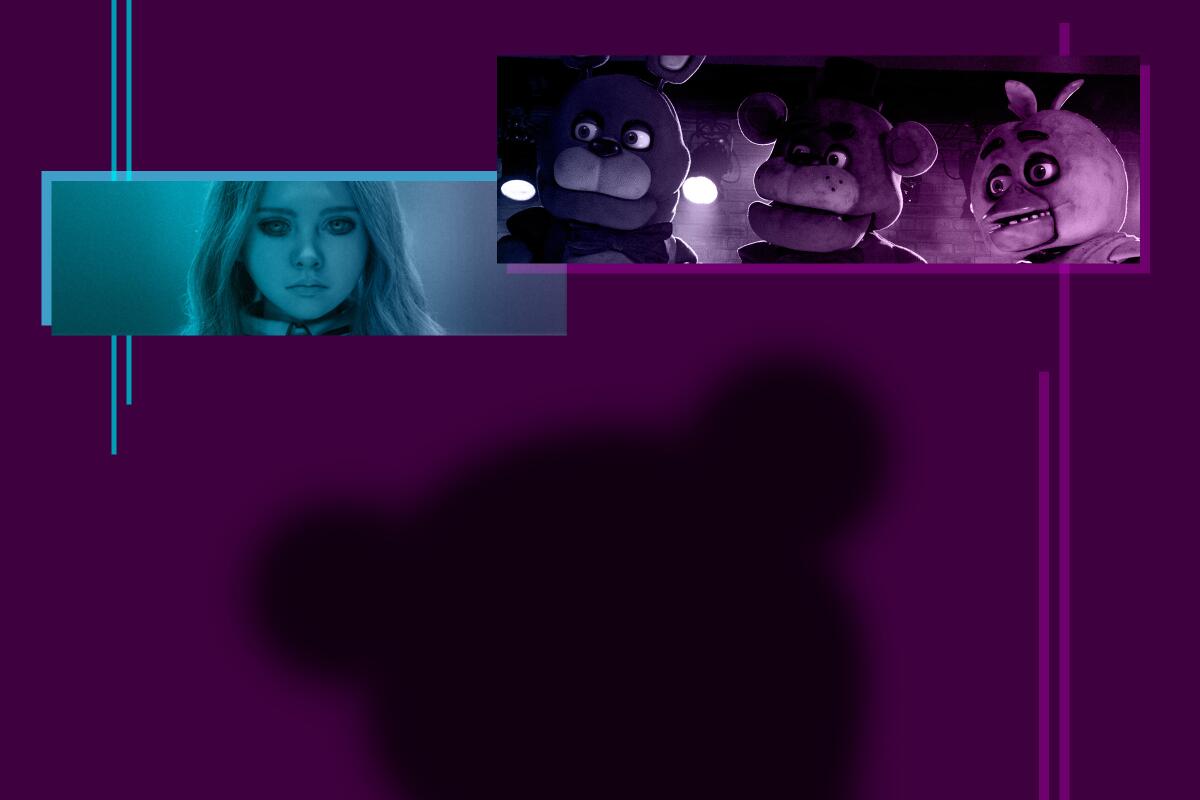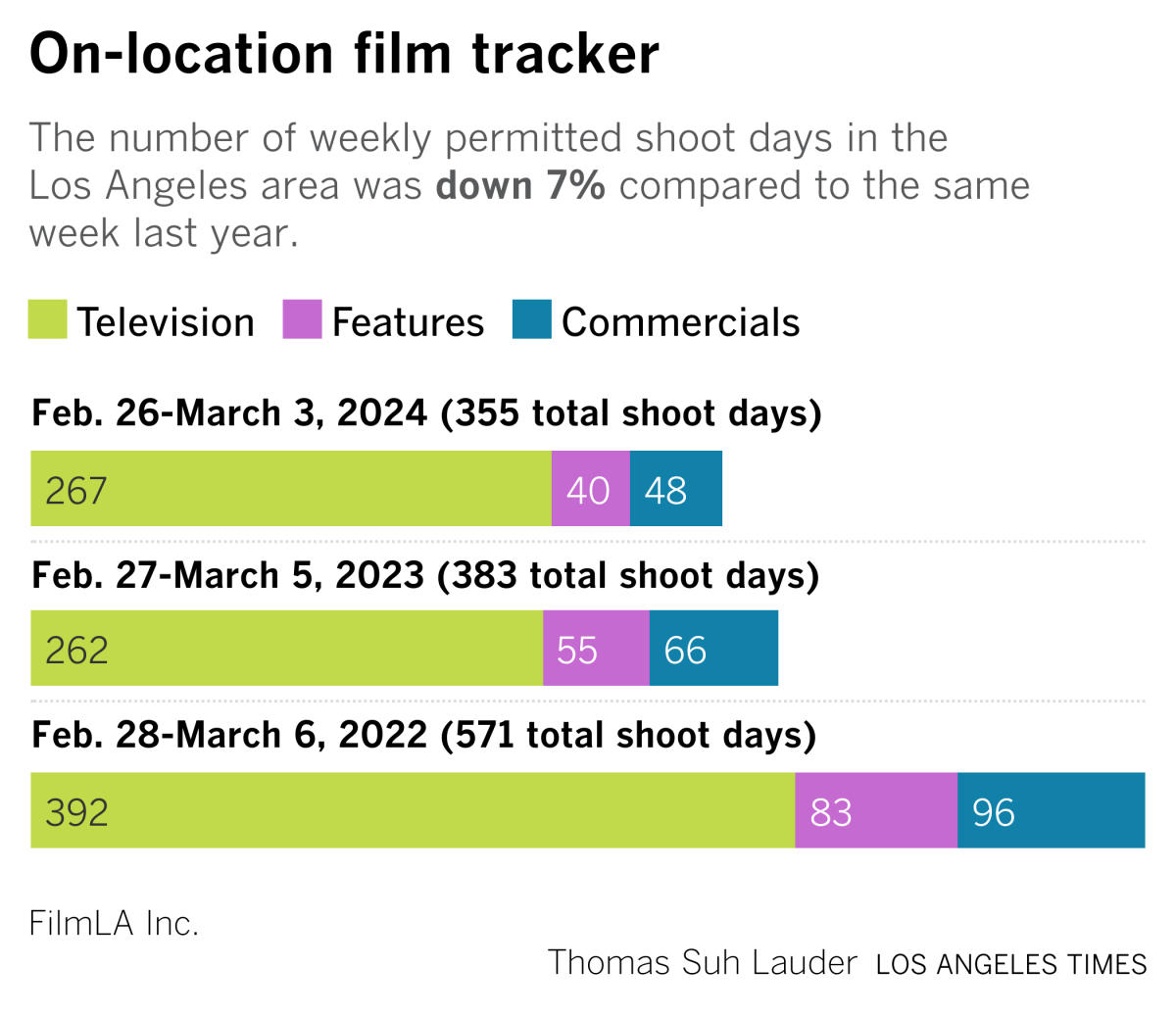From ‘Imaginary’ to ‘Five Nights at Freddy’s.’ Why Blumhouse loves PG-13 horror

- Share via
Horror films have long been among the most reliable profit centers for Hollywood studios, even as other categories of film — like rom-coms, raunchy comedies and even superhero flicks — cycle through ups and downs. Within that ever prolific heading is a subset of titles that have shown themselves to be a dependable way to get younger audiences to the local multiplex: the PG-13 horror movie.
This weekend Blumhouse releases its latest effort, “Imaginary,” which follows a woman whose young stepdaughter befriends a creepy stuffed bear named Chauncey. Lionsgate is distributing the film, which is expected to open with about $10 million to $12 million at the domestic box office on an estimated production budget of $10 million, according to people who’ve reviewed pre-release audience surveys. That would be comparable to “Night Swim,” which opened to $11.8 million in January.
It’s the latest spooky PG-13 Blumhouse pic, following the success of “Five Nights at Freddy’s” ($291 million in global box office sales) and “M3gan” ($180 million). Both “Five Nights” and “M3gan” were distributed by Universal Pictures.
Blumhouse sees an opportunity to expand the market for the horror genre as the company itself grows through its merger with James Wan’s Atomic Monster. The Los Angeles-based producer is trying to make movies that young people can watch with other family members. The idea is that if the pictures work, they’ll hit not just with Gen Z, but with their parents and siblings as well.
Backing up this point, in a recent Blumhouse-commissioned survey of self-identified horror fans, 70% of Gen Z respondents reported watching horror movies with their moms while 65% have watched them with their fathers. Including other generations, 60% of survey participants said they’d watched with Mom, versus 49% with Dad, 44% with a sister and 39% with a brother. Sixty-nine percent said they consider watching horror movies a family bonding activity.
“You wouldn’t think of these as ‘family movies,’ but the audience can be a family audience for these and that’s how something like ‘Five Nights at Freddy’s’ can gross almost $300 million at the box office,” Blumhouse President Abhijay Prakash told The Wide Shot. “When you have that PG-13 rating, it opens up the opportunity for parents, siblings and the child to all go, and that really came across in the data in a big way.”
The research provided to The Times, based on a September online survey that received 1,655 complete responses, was conducted by Sage Outcomes for Blumhouse.
PG-13 horror movies are not a recent phenomenon, of course, despite the broader genre’s subversive bent and the reputation for luridness and exploitation earned by the ‘80s slasher movies and their descendants. Joe Dante’s Christmas-themed horror-comedy “Gremlins,” rated PG, helped originate the PG-13 rating in 1984 after parents complained about its inappropriateness for smaller children.
Since then, films including “The Ring” and “A Quiet Place” have repeatedly reinforced the fact that studios can deliver genuine scares without pushing into hard-R-rated territory (though to this day, movies designed to scare the younger set raise questions about whether the Motion Picture Assn. is too lenient when it comes to violence and frightening imagery).
And teenagers have long been a key demographic for the genre, regardless of the MPA designation. Think of how many movies became cult classics thanks in large part to the slumber party audience. Plus, horror is typically inexpensive to produce, making profitability easier to achieve, as is the Blumhouse way.
Part of horror’s endurance at the box office has been attributed to the unique experience of seeing something scary in a theater with a group, which is hard to replicate on the couch. What the survey data suggests is that the crew in question “doesn’t necessarily need to be your peers and friends, it can also be your family,” said Prakash.
Teens and tweens have been a lucrative audience for Hollywood across multiple genres. As my colleague Christi Carras recently wrote, there’s a reason studios and streaming services are still apt to spend serious coin on fantasy-adventure series aimed at younger viewers — such as Disney+’s “Percy Jackson and the Olympians” and Netflix’s “Avatar: The Last Airbender” — even as budgets tighten in other areas. Good teen-oriented TV-PG programs can easily become family viewing, making them “four-quadrant” hits.
In horror, some movies can also have cross-generational appeal, such as the most recent three-part reboot of the “Halloween” franchise, even though those films were rated R.
The post-millennial generations are also helpful to studios because of their penchant for meme-ing their favorite content into viral social media sensations. So making films relevant to their world makes sense, and this certainly applies to horror. “M3gan,” for example, exploited fears of artificial intelligence and skewered the ersatz reality of life spent on electronic devices. “Five Nights at Freddy’s” was based on a video game franchise popular among the youth.
Not every movie is going to hit the mark. “Lisa Frankenstein,” a horror-comedy from Focus Features, hasn’t exactly sent folks rushing to the cinema ($9.7 million in box office sales as of Monday). And there’s still a big audience for far edgier material, as A24 demonstrated last year with its twisted supernatural Australian chiller “Talk to Me.” But we can surely expect to see more PG-13 frights in the coming years, especially with these movies becoming family affairs in some cases.
“We’re striving to be the ultimate scary story company, and that means serving all types of audiences,” Prakash said. “Clearly, there’s an audience here, and now that’s validated with data on younger audiences and cross-generational audiences. So we want to serve that audience with our movies, but also our TV shows and, eventually, our games. So it is an important part of what we’re building out.”
You’re reading the Wide Shot
Ryan Faughnder delivers the latest news, analysis and insights on everything from streaming wars to production — and what it all means for the future.
You may occasionally receive promotional content from the Los Angeles Times.
Stuff we wrote
Hollywood crew members take center stage as IATSE negotiations kick off. IATSE and Teamsters, two unions representing Hollywood crew members, are entering contract negotiations with the studios after the writers’ and actors’ strikes.
Netflix hires ‘It’ producer Dan Lin for top film job, replacing Scott Stuber. Dan Lin, whose production company, Rideback, is located in L.A.’s Historic Filipinotown, has produced films including the “Lego” and “It” movies.
‘Percy Jackson,’ ‘Avatar’ and epic coming-of-age tales are getting their live-action TV moment. Thanks to streaming, preteens are finally getting a chance to see themselves as live-action heroes in TV epics such as “Percy Jackson” and “Avatar.”
Disney’s heirs snub activist investors and throw their support behind Bob Iger. The Disney proxy battle is heating up as the heirs of Walt and Roy Disney, the company’s founders, throw their support behind the current regime, not Nelson Peltz or Blackwells.
‘Road House’ brawl: Amazon used AI to replicate actors’ voices during strike, lawsuit alleges. Screenwriter Lance Hill alleges that Amazon MGM Studios used artificial intelligence to simulate actors’ voices. The studio said the remake “does not use any AI in place of actors’ voices.”
Historic movie theater in Highland Park closes after 100 years. Highland Theatre struggled to bounce back from the COVID-19 pandemic.
The docket:
- ‘Rust’ director Joel Souza describes being injured in Alec Baldwin shooting: ‘Nothing made sense’
- Dramatic ‘Rust’ shooting testimony: ‘The gun went off’ and then, ‘I can’t feel my legs’
- Ex-Verve boss Bill Weinstein sues agency in effort to reverse his ‘surprise ouster’
- Journalist held in contempt for refusing to reveal sources in Fox News investigation
Number of the week
$81.5 million
Warner Bros. and Legendary’s “Dune: Part Two” launched with a strong $178.5 million in worldwide ticket sales, including $81.5 million at the U.S.-Canada box office, giving theaters a much needed hit after a stormy couple of months.
Denis Villeneuve’s well-reviewed sequel easily topped the $41-million debut of its 2021 predecessor (which was released simultaneously on HBO Max) and beat pre-release estimates, including Warner Bros.’ own low-ball projection of $65 million.
What really counts, though, is the space opera’s profitability. With a $190 million production budget, plus the costs of a global blockbuster promotional campaign, the film is not there yet, but rave responses from audiences, judging by its “A” CinemaScore, suggest that this one’s in a good position.
$8.5 billion
Bob Iger is throwing in the towel on Disney’s India business. The company will merge its Star India unit with Reliance Industries-owned Viacom18, forming a joint venture valued at $8.5 billion, according to the companies. The new operation will be chaired by Nita M. Ambani, the wife of Reliance topper and billionaire Mukesh Ambani. Former Disney and Fox executive Uday Shankar, who had joined Viacom18, will serve as vice chairperson.
The Mouse House has had a tough go of it in India, the world’s most populous country, ever since the company forfeited Indian Premier League cricket streaming rights — to Reliance — under Bob Chapek. Hotstar, Disney’s direct-to-consumer service in India, was losing subscribers, who on a per-customer basis didn’t bring much money to the company in the first place. Now Disney will hold a minority stake in the newly formed joint venture, with Reliance owning 63%.
Film shoots
The latest on-location production data from FilmLA, with year-over-year comparisons.

Best of the web
— Why Universal Music used the “nuclear option” against TikTok. (Wall Street Journal)
— Uncovering the higher truth of Jay Shetty, the self-help guru to the stars. (The Guardian)
— The best reason to watch the Oscars this year, according to Glenn Whipp. No, it’s not the widely presumed dominance of “Oppenheimer.” (LAT)
Finally ...
How does one describe Glitterer, the Washington, D.C.-based band that was once the one-person solo project of Ned Russin and has morphed into a four-piece rock band with heavy punk rock and power-pop influences? Hard to say, but the group’s new album, “Rationale,” is fun, infectious and loud, and that’s good enough for me.
The Wide Shot is going to Sundance!
We’re sending daily dispatches from Park City throughout the festival’s first weekend. Sign up here for all things Sundance, plus a regular diet of news, analysis and insights on the business of Hollywood, from streaming wars to production.
You may occasionally receive promotional content from the Los Angeles Times.




